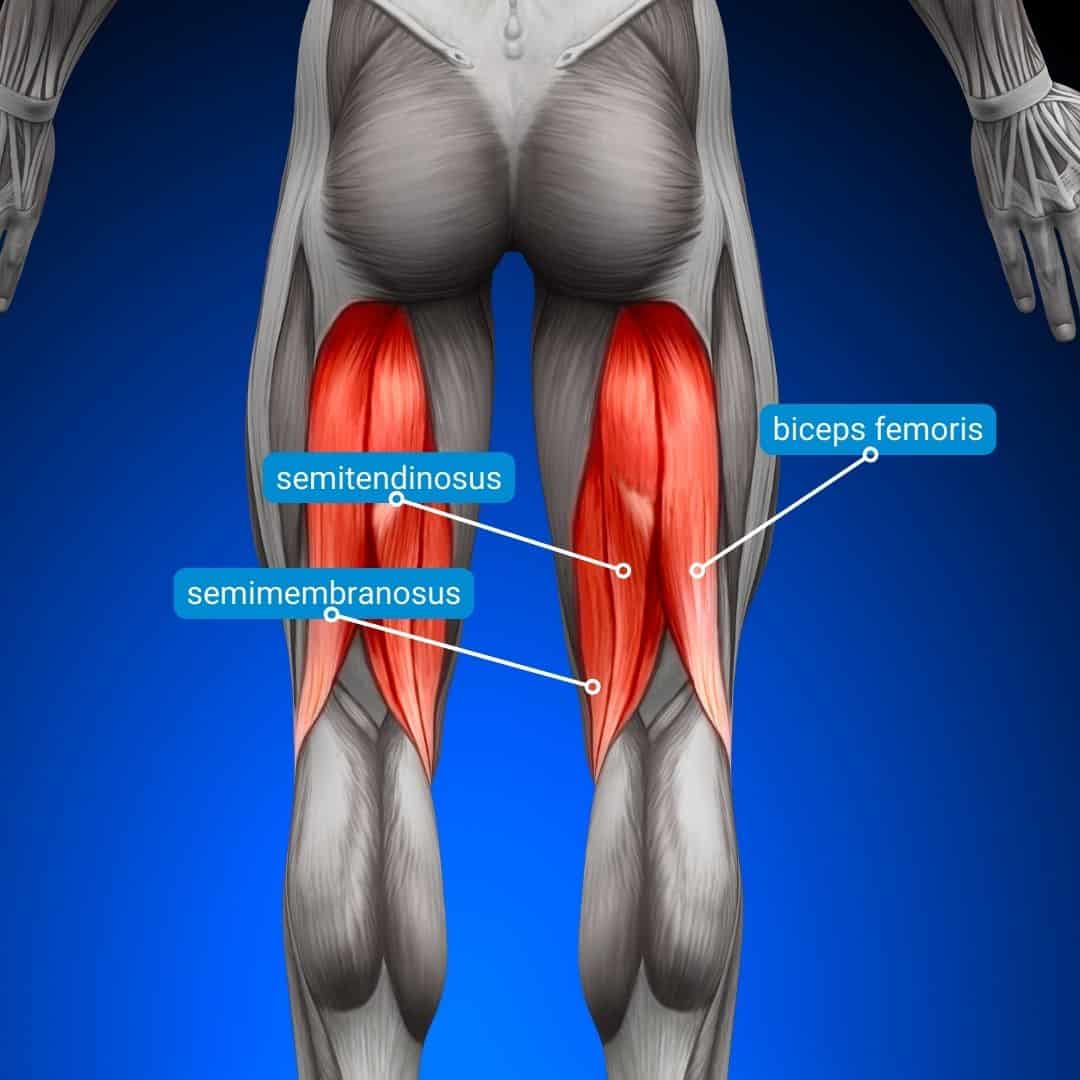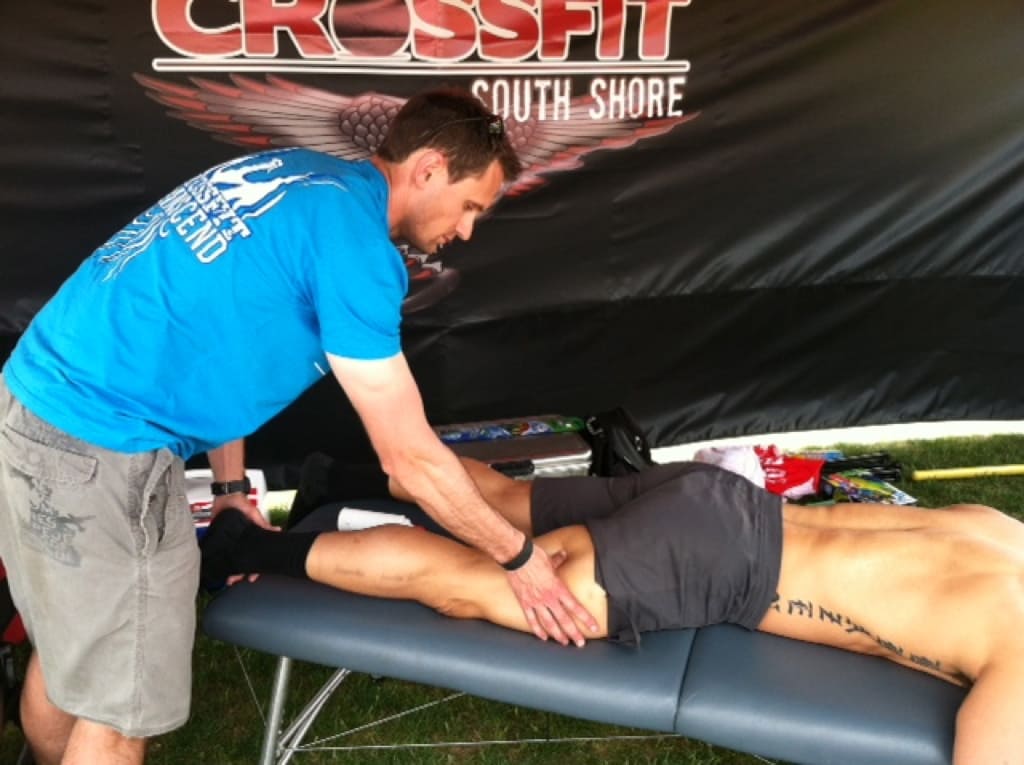Over the last few months, I have seen a slight increase in the number of hamstring injuries in the office. I don’t personally think there is a rhyme or reason, just as the old saying goes when it rains it pours. The hamstrings are one of the most common muscles injured in running sports such as soccer, baseball, football, or running/sprinting. Hamstring injuries often occur at the moment an athlete pushes off to begin running, or over-stretches the muscle such as a baseball player reaching for first base.
Anatomy of the Hamstrings

The hamstring muscles consist of three main muscle bellies:
- The biceps femoris,
- semitendinosus,
- and semimembranosus.
These muscles are in the posterior aspect (or back) of the thigh and help provide the body with both knee flexion (bending the knee) and hip extension (bringing the hip and leg backward). These movements play a critical role in the gait cycle of walking and running. In my opinion, the hamstring is one of the most underworked and least noticed muscles, however it plays such a critical role in the athletic world.
Common Types of Hamstring Injuries
At True Sport Care we usually deal with 2 types of hamstring injuries.
1. Hamstring Strain (“Pulled Hamstring”)
Hamstring strain (aka “pulled hamstring”) or partial thickness tears of the hamstring are by far the most common types of hamstring injury that we see in our sports medicine office.
What a hamstring strain injury feels like
- These injuries are typically described by patients as a “pulling” or “stretching” sensation in the hamstring while performing their sport or activity.
- More complex hamstring injuries, severe partial tears or complete tears are generally described as feeling as if they were “kicked” or “struck” in the back of the thigh. These types of tears often require medical intervention and sometimes surgical intervention.
2. Hamstring Tendinosis
Another common type of hamstring injury that we see quite often in the office is tendinosis of the proximal hamstring tendon, big fancy words for irritation of the hamstring tendon.
What hamstring tendinosis feels like
- Hamstring tendinosis is often characterized as a deep nagging ache in and around the area of the ischial tuberosity (or that bone when someone sits on your lap, and you tell them they have a bony butt).
This injury is often caused by overuse or repetitive pulling of the hamstring tendon on its bony origin. While these injuries differ from the hamstring tears discussed earlier, they can be just as nagging and annoying to deal with!
Diagnosis and Assessment of the Hamstring Injury
Diagnosing hamstring injuries is generally straightforward through the patient’s history, mechanism of injury, and physical examination. The physical examination can be performed by several different healthcare providers including physicians, chiropractors, or physical therapists. These injuries are generally diagnosed through assessing the range of motion of the hamstring, manual muscle testing, and or palpation of the muscle belly itself. For the most part, muscle testing gives us the greatest diagnostic input as we look for pain with associated weakness in the muscle. The greater the weakness, most likely the more severe the tear. When a tear is suggested or thought to be more severe, a referral for an MRI is typically warranted to further evaluate the extent of damage.
Immediate Hamstring Injury Treatment Options
Hamstring injuries can typically be treated non-surgically. Some great home treatment options prior to coming to the office for treatment include:
- Rest: Rest is crucial in the initial stages of a hamstring injury. It allows the injured muscles to heal by reducing further strain and preventing additional damage. Avoid strenuous activities and give your body time to recover.
- Activity Modification: Modify your daily activities to minimize the use of your injured hamstring. This may involve avoiding activities that exacerbate the injury, such as running or heavy lifting, and opting for gentler movements to reduce stress on the muscle.
- Compression: Applying compression with a bandage or elastic wrap can help reduce swelling and provide support to the injured area. Ensure the compression is snug but not too tight to avoid cutting off circulation.
- Ice or Heat: In the acute phase of injury, applying ice (cold therapy) can help reduce pain and inflammation. Use a cold pack wrapped in a cloth for 15-20 minutes at a time. In the later stages, heat therapy can promote blood flow and relaxation of the muscles, aiding in the healing process.
- Elevation: Elevating the injured leg can further reduce swelling and improve blood circulation. Prop your leg up on pillows or cushions to keep it elevated above heart level when resting.
- Topical Creams (e.g., Arnica or Voltaren): Topical creams containing ingredients like Arnica or Voltaren can provide localized relief by reducing pain and inflammation. Follow the product’s instructions for application and consult with a healthcare provider if you have any concerns.
- Over-the-Counter Nonsteroidal Anti-Inflammatory Medications: Over-the-counter medications like ibuprofen or naproxen can help manage pain and inflammation. Always follow the recommended dosage and consult a healthcare professional if you have any questions or if your symptoms worsen.
Remember that while these at-home treatment options can be beneficial in the initial stages of a hamstring injury, it’s essential to seek professional medical advice for a thorough evaluation and a tailored hamstring injury treatment plan to ensure a full and safe injury recovery as well as fast return to sports and activities.
Rehabilitation Techniques for Hamstring Injuries

Treatment and rehabilitation protocols for hamstring injuries in the office vary patient by patient depending on the severity of the hamstring injury and the patient’s state.
- Sometimes passive modalities such as electrical muscle stimulation and ultrasound are utilized to help promote blood flow while also acting as a pain modulator.
- Soft tissue manual therapy such as myofascial release, an aggressive type of massage, is also utilized. While this type of treatment can be initially painful for the patient it is useful in the healing process in avoiding potential scar tissue formation within the muscle fibers.
- One of the most important treatment factors in the rehabilitation of hamstring injuries is strength training. This can be complex and lengthy depending on the severity of the tear. Strengthening exercises can vary from activations (simple muscle engagement with range of motion), isometrics (contracting the muscle without lengthening), concentric training (shortening the muscle), or eccentric training (lengthening the muscle).
Examples of Hamstring Strengthening Exercises Prescribed as Part of the Treatment
Hamstring activation
Hamstring ball drag – concentric and eccentric
When Can Athletes Return Back to Sport after a Hamstring Injury?
One of the most frequently asked questions in the office regarding any injury is “When can I return to my sport?”. This is a complicated question that often brings on a discussion with the patient/athlete regarding his or her goals with returning to sport. As mentioned earlier, activity modification is a great at-home “DIY” treatment, however this can also be utilized to return to sport.
If the athlete is a long-distance runner, a simple return to sport protocol might be having the patient jog 400 meters at a super slow pace to assess the “feel” of the hamstring, and then gradually work the athlete back to his or her pace and distance.
Shameless plug coming, one of the things that we pride ourselves on at True Sport Care is minimizing the downtime for the athlete and producing superior results to traditional medical approaches.
How to Prevent Hamstring Injury Reocurrence
When it comes to hamstring injuries, or any musculoskeletal injuries the biggest predictor of an injury is a prior history. What does this mean? If you have suffered numerous ankle sprains in the past you have a greater likelihood of spraining your ankle again. However, prevention of such injuries is possible. As discussed above, strengthening exercises are one of the best and most effective ways to prevent the reoccurrence of muscle injuries. Loading a muscle and building strength will help to limit potential injury down the road. However, there will always be instances where the load is just too much on a muscle and the muscle itself will fail.
Conclusion
In summary, hamstring injuries are common and can be quite often frustrating for an athlete. However if properly managed at home and treatment is initiated quickly and properly the results can be beneficial in returning the athlete to his or her sport quickly.
References
- Proximal Hamstring Injuries: Management of Tendinopathy and Avulsion Injuries. National Library of Medicine
- Hamstring Injuries in the Athlete: Diagnosis, Treatment, and Return to Play. National Library of Medicine
- Rehabilitation and return to sport after hamstring strain injury. National Library of Medicine




